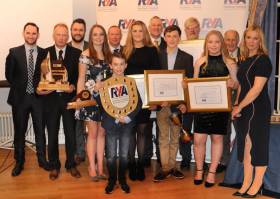Displaying items by tag: RYANI Annual Awards
Nominations Open for RYA Northern Ireland Annual Awards 2022
RYA Northern Ireland has announced the return of its annual awards, including a brand new category, which will recognise the region’s unsung heroes of sailing and boating.
The awards, which had been on hold since 2019 due to COVID, are are back with a bang this year and promise to be bigger and better than ever.
Voting is now open with a simplified application process and two new categories: Race Official of The Year and Chair’s Award. See the RYANI website for more details.
Nominations will close at midnight on Friday 17 February, with the awards event will then taking place in April 2023. Nominations should focus on impact that was made between January and December 2022.
RYANI’s chief operating officer Greg Yarnall says: “We are excited to restart the RYA Northern Ireland awards again this year and get 2023 off to a celebratory start.
“We are also taking the opportunity to introduce a new category, Race Official of the Year. Many of our participants enjoy competing throughout the year and without our race officials, these events just wouldn’t be able to happen. We wanted to ensure they too were recognised, alongside our volunteers, instructors and coaches.”
Susan McKnight, chair of RYANI, added: “I am delighted that this year we will have a Chair’s Award. I would ask our sailing and boating community that if they know of a club, centre, person or group who deserve recognition — but do not fall within the other categories — to get in touch and let us know.
“The award will be decided upon by myself and we want to ensure that we recognise someone very special who has achieved something exceptional or gone above and beyond.”
Liz Baker, chair of the RYANI development committee said: “Volunteers are the bedrock of our sport — without them, we simply would not be able to do any of our events and many of our clubs would not exist. There are people right across Northern Ireland who give up their time each and every week to ensure that sailing and boating continues to thrive.
“It is fantastic to be able to celebrate these unsung heroes and I am delighted that this year we will have the Annual Awards and recognise those who do so much for our sport.”
The full list of categories is as follows:
- Chair’s Award nomination
- Race Official of the Year
- Volunteer of the Year
- Instructor of the Year
- Club Race Coach of the year
- Young Powerboater of the Year
- Young Volunteer of the Year
- Young Sailor of the year (this will be decided in house by the performance committee)
The Club of the Year will be awarded but will be run separately from the Annual Awards so that they can be aligned with the RYA Club of the Year process.
RYA Northern Ireland Launches 2019 Annual Awards
The RYANI is calling on clubs across Northern Ireland to nominate their sporting heroes for its the Annual Awards, sponsored by Garden Rooms NI.
This year’s awards evening will be held on 17 January 2020 at Queen’s University Belfast’s Riddel Hall.
For the last few years, the awards recognise all the good work by volunteers in clubs and centres across the province.
Richard Honeyford, RYANI chief operations officer, said: “I am very pleased to be launching the awards, which have been growing from strength to strength since becoming a standalone event in 2015.
“The event has gained the support of Garden Rooms NI. The family owners are sailors themselves with a daughter who recently completed her RYA Dinghy Instructor award, and they want to give back to a sport that means so much. We are, of course, very pleased to have them on board.”
RYANI chairman Jackie Patton added: “This event is the highlight of the year, reflecting growing participation in our sport. The growth is due to hard work and good practice in our clubs and beyond, by the plethora of volunteers and workers. It is a great opportunity for us all to meet and celebrate.”
Nominations can be made in the following categories:
- Instructor of the Year
- Club Race Coach of the Year
- Volunteer of the Year
- Young Volunteer of the Year
- Young Powerboater of the Year
Also awarded on the night will be Young Sailor of the Year, nominated by the RYANI Performance Committee, and regional Club of the Year.
Following on from last year’s awards, clubs wishing to be considered as Club of the Year must nominated themselves via the RYA’s national competition, in association with Yachts & Yachting and supported by Gallagher.
The Club of the Year awards recognise the outstanding achievement of sailing clubs across the UK, and all 1,000 sailing clubs in Great Britain and Northern Ireland are eligible to apply.
The RYA Awards Panel will select a finalist for each of the 10 RYA regions and Home Counties, as well as two ‘wild card’ entries.
During this shortlisting stage, the panel will provide five clubs with recognition for particular achievements in the following five areas: boosting membership; innovation and forward thinking; inclusivity; facilities; and embracing modern communication.
All finalist clubs will then go through to a public vote, with the overall winner selected by RYA members, Yachts & Yachting readers and the panel. The 2020 Club of the Year will be announced at the RYA Dinghy Show at London’s Alexandra Palace from 29 February to 1 March 2020.





























































